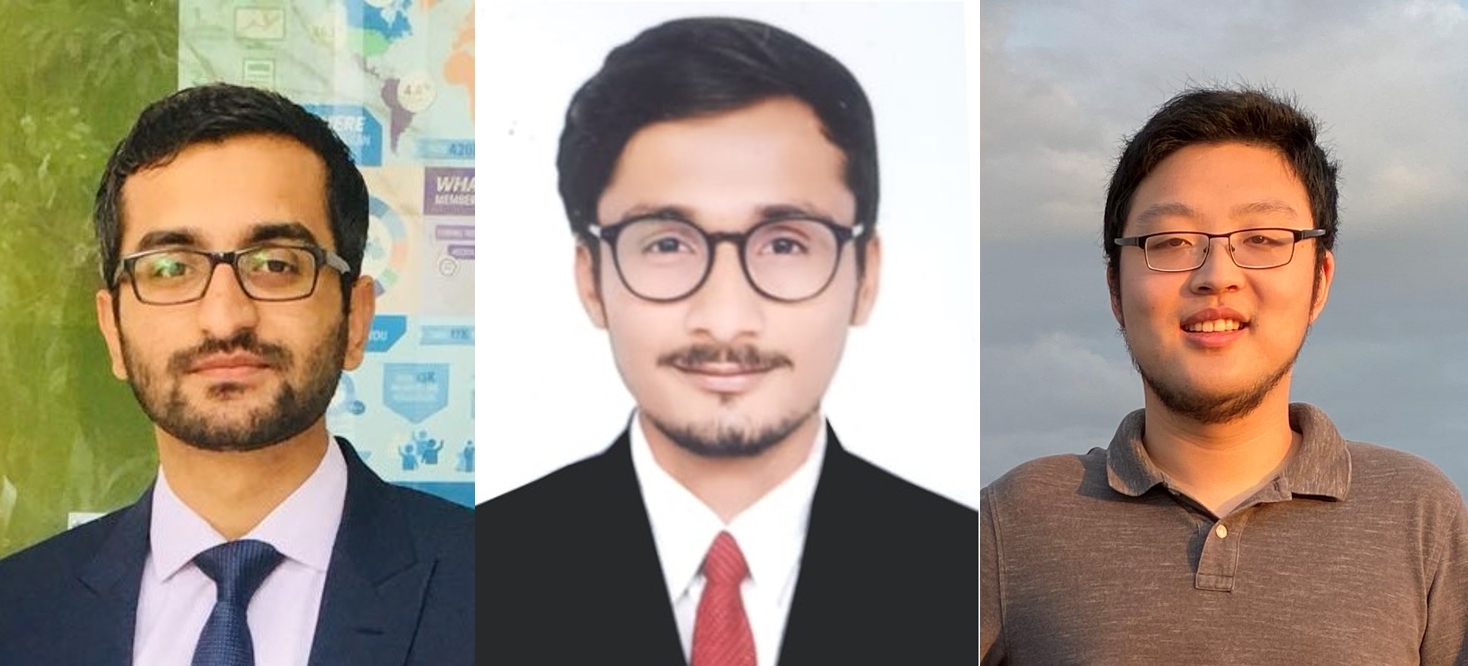Leading the Charge in Dr. Luo's High Voltage Haven

Dr. Fang Luo students Abdul Basit Mirza, Kushan Choksi, and Austin Zhou
This may shock you, but high-voltage power electronics – that is, electronics designed to control and convert electric power – is a critical component of a technologically advanced and energy-efficient future.
The evolving power electronics field has a definite frontier and its share of recognized pioneers. Among them: Dr. Fang Luo, a Stony Brook University Empire Innovation Associate Professor and director of the university’s Spellman High Voltage Power Electronics Laboratory.
Knee-deep in power-electronic converters, electromagnetic interference (EMI) models and power-module packaging, Dr. Luo – a former assistant professor at the University of Arkansas, a Senior member of IEEE, plus card-carrying member of the American Society of Mechanical Engineers and the American Institute of Aeronautics and Astronautics – leads a laboratory that offers hands-on experiential training in high-voltage energy conversion, designed to give students a leg up on professional internships and competitive graduate-school slots.
Like Dr. Luo himself, the laboratory – opened in 2022 in collaboration with Hauppauge-based Spellman High Voltage Electronics Corp., a leading global manufacturer of X-ray and high-voltage conversion technologies – is a rarity in the power-electronics field.
Among its primary benefactors are Dr. Luo’s many students, who benefit equally from an unparalleled mentor (one book, 40-plus journal papers, 100-plus peer-reviewed conference papers and counting) and the fantastic laboratory facilities inside SBU’s Advanced Energy Research and Technology Center.
Electrical engineering doctoral candidate Austin Zhou – who concentrates primarily on power electronics related to health monitoring, while dabbling in the EMI of high-voltage power applications – considers the AERTC “a great research facility for high-power testing,” stocked with advanced modeling and validation technology and a welcome community of scientific minds.
“The open environment of the facility allows students and professionals to engage in friendly conversation without issue,” Zhou notes. “This allows researchers from all kinds of backgrounds to develop and sharpen skills in a professional environment.”
Electrical engineering doctoral candidate Kushan Choksi also commended the AERTC’s “vision of superiors, peers and staff” working together, making the Advanced Energy Center both “conducive for futuristic research and a learning center for students.”
“We can communicate and learn from interdisciplinary labs to solve challenging research problems,” Choksi says, a collaborative environment maximized by “a supportive and innovative mentor” in the Spellman Laboratory director.
“Dr. Luo is a creative engineer and innovator,” Choksi adds. “He is equally acceptive and encouraging toward new research ideas originating from industry, colleagues and students, and is very accessible for discussing research, professional or personal concerns one might face during and after doctoral studies.”
Graduate student Abdul Basit Mirza, who’s closing in on a doctor of philosophy degree in electrical engineering, credited Dr. Luo’s big-picture approach to a field that is both immensely important and constantly changing.
“His concept of research is to explore latest challenges in interdisciplinary areas related to power electronics, to have broad understanding when doing research,” Mirza says. “I second this approach, as the power electronics field is evolving at a steep rate and new challenges are coming in.
“Further, he always has a positive attitude toward the issues brought up in group meetings about projects,” Mirza adds. “[Dr. Luo] observes patience and perseverance in clarifying the doubts.”
Like his fellow doctoral candidates, Mirza – part of a team that partnered with scientists at Oak Ridge National Laboratory and the Federal Aviation Administration on the system-level design of high-density power converters (and related EMI characterizations) – applauded the AERTC as “an interdisciplinary research center with the latest facilities.”
“The work environment is inclusive … you get a chance to communicate and work with peers from other disciplines,” he notes. “For instance, I had an opportunity to work with [SBU Adjunct Professor of Electrical Engineering Slowa Solovyov] in developing a microgrid … his knowledge in material science helped me to get a better perspective on designing insulation for high-voltage systems.”
Those sorts of shared wins are a key benefit of the AERTC’s collaborative design. But nothing keeps a young researcher like Choski – who’s centered on diagnostics, prognostics and control systems for ultra-competitive, uber-technological machine drives – focused better than having the right team around him.
“I would really like to thank Dr. Luo, Dr. Solovyov, (AERTC Director) Jim Acquaviva and (AERTC Senior Administrative Assistant) Carol Duprez for their support in research,” Choski says.
According to Mirza, his quest to identify new topologies and architecture to increase power densities and lower EMI in future power electronics would be even more difficult without the AERTC’s cutting-edge equipment and focused leadership.
“From my research area perspective, the building is equipped with all required instruments and protocols, making high-power testing safer,” Mirza says. “The management is humble and supportive to help out with the challenges.
“I and my team would personally like to acknowledge the support from Jim Acquaviva for helping us out during testing,” he adds, “as well as shipping out our research prototype to Oak Ridge National Laboratory.”
